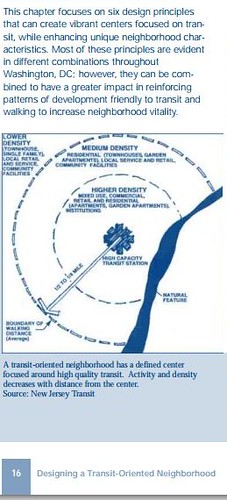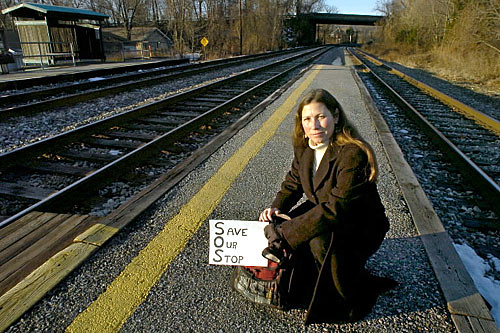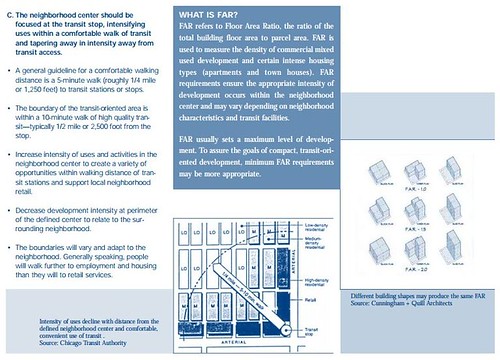Bad Montgomery County policy/law initiative #1: removing density bonuses for building around MARC train stations

from the out-of-print DC Office of Planning publication, Trans-Formation: Recreating Transit-Oriented Neighborhood Centers in Washington, DC | A Design Handbook for Neighborhood Residents.
While I didn't get quoted in the WBJ article, "Transit-oriented development? Not at MARC stations, bill says," on this subject, I aver my points were far better than what ran in the story, although they needed some polishing, and they were just from email, but we didn't get a chance to talk because I was traveling. (Also see "Growth-limit bills reflect regrets in Montgomery" from the Gazette.)
A pair of Montgomery County council members have introduced legislation that would remove the density bonus points a developer receives if it builds within a mile of a MARC station in a Commercial-Residential Zone. The argument is, the point of transit-proximity benefits is trip reduction, and MARC barely registers as a trip reducer compared to Metro. The legislation emerged from discussion of the Kensington Sector Plan, which has MARC but no Metro, and is in line to be a CR Zone.
Here was my response (now augmented):
In the short run, Councilmembers Leventhal and Elrich are absolutely right.
With some exceptions like those serving Ft. Meade or New Carrollton or Penn Station, West Baltimore, etc., for the most part the stations are in distant locations, reflecting the very old railroad and traditional "Anglo-American" suburbs commuting station patterns of development (like Philadelphia's Main Line).
HOWEVER, if we think that way, we are dealing with the wrong scale and time frame.
The real question is what if the stations were in fact key elements of active places? WHAT if the MARC Growth and Investment Plan comes to fruition, with maybe not 24/7 service but 18/7 service--including weekends, which aren't served now?
If those are the right questions, then the right answers have to do with how to create the right environment to support 18/7 service on the MARC railroad lines and reposition the service away from an almost exclusively daytime commuter service to and from Washington (and Baltimore), but more like how railroad service in cities like Greater New York, London, Philadelphia, and Paris is but another transportation mode, complementing more local transit service.
MARC will never have the right environment to justify 7 day service not just focused on commuters to DC and Baltimore as called for in the Growth and Investment Plan as long as the majority of stations are little outposts in distant locations--the kind of stations they are today--with limited development around the station.

"We don't need fancy things," says Brenda Klaunberg, a 44-year-old veterinarian who commutes on the MARC Camden line to the National Institutes of Health in Bethesda. "We just want to get on and off." (Baltimore Sun photo by Amy Davis) Dec 21, 2005.
For what it's worth, my ideas on the mobilityshed, transit shed, and "metropolitan mass transit planning," were generated in part wrt the plans under former Governor Ehrlich to close a bunch of MARC stations, and the spirited reaction which successfully warded off closure, even though collectively fewer than 100 people use(d) the targeted stations on a daily basis.
One of the points people made was that station use was limited because there wasn't enough, opining that lack of parking prevented higher use of these low use stations--they're right, there isn't much parking--but the real issue is the fact that the railroad network service pattern as it is today doesn't go to places where people in those distant places are likely to go.
So while I think that Councilmembers Leventhal and Elrich are right in the very short run, the issue is that they are thinking on the wrong time frames--they need to be thinking for the next 3-4 decades, not this one.
Note that the blog entry from the other day, "Transit oriented development can take decades to realize, so two years is too short of a time to be expecting it (Austin Texas)," is another illustration of how development at transit stations need to be considered over very long time frames. In my comments on that piece, I used the now underway "Monroe Market" development in Brookland as another example of how long it takes projects to be created--that one will open about 35 years after the station opened.
-----
Note that the basic ideas aren't different from how trolley/streetcar suburbs were developed in the 1800s and early 1900s, it's just that the scale of development needs to be more intensive now, because sprawl has deconcentrated metropolitan areas so much.
See the discussion of streetcar suburbs from Wikipedia, and the out-of-print DC Office of Planning publication, Trans-Formation: Recreating Transit-Oriented Neighborhood Centers in Washington, DC | A Design Handbook for Neighborhood Residents.

Page 18, Trans-Formation: Recreating Transit-Oriented Neighborhood Centers in Washington, DC | A Design Handbook for Neighborhood Residents.
Labels: leadership-vision, legislative process, real estate development, transit oriented development, transportation planning, urban design/placemaking



0 Comments:
Post a Comment
<< Home